INSTITUT SUPERIEUR D'ANTHROPOLOGIE
INSTITUTE OF ANTHROPOLOGY
ONLINE COURSES / COURS A DISTANCE
DEBUT COURS : AVRIL 2023
REGISTER NOW
MEXIQUE – 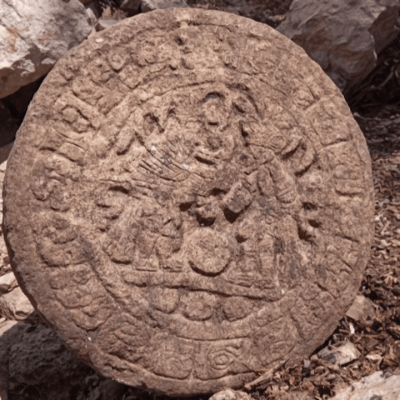 Chichen Itza - Mexican archaeologists found a circular-shaped Mayan scoreboard used for the ball game at Chichen Itza archaeological site, Mexican Anthropology and History Institute (INAH) said on Monday. The disc features the carving of two ball game players and was found in the Chinchanchob architectural complex. Experts say the scoreboard dates to the Early Postclassic period between the years 800 AD and early 900 AD. This is the first discovery in over eleven years of an object with hieroglyphic writing -- in this case a complete text -- at Chichen Itza, according to INAH.
Chichen Itza - Mexican archaeologists found a circular-shaped Mayan scoreboard used for the ball game at Chichen Itza archaeological site, Mexican Anthropology and History Institute (INAH) said on Monday. The disc features the carving of two ball game players and was found in the Chinchanchob architectural complex. Experts say the scoreboard dates to the Early Postclassic period between the years 800 AD and early 900 AD. This is the first discovery in over eleven years of an object with hieroglyphic writing -- in this case a complete text -- at Chichen Itza, according to INAH.
https://local12.com/news/offbeat/mexican-archaeologists-discover-mayan-scoreboard-chichen-itza-early-postclassic-period-hieroglyphic-writing
ITALIE – 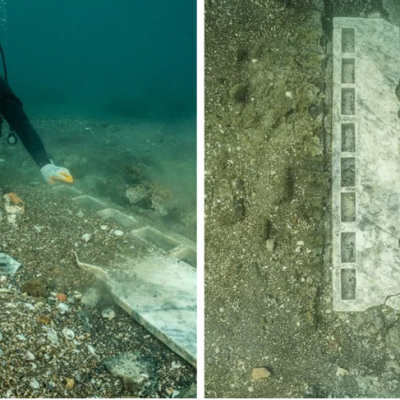 Pozzuoli – Underwater archaeologists have identified a submerged temple of the Nabataeans. The temple remains are located off the coast of Pozzuoli, situated on the Phlegrean Peninsula in the Italian region of Campania. During the Roman period, the Nabataean kingdom was an ally of Rome that ruled a territory stretching from the Euphrates to the Red Sea. The kingdom served as a bulwark between Rome and the wild hordes of the desert, centred on the capital city of Petra. At the time, Pozzuoli, known as Puteoli in antiquity, was the main hub for goods exported from Campania. The Nabataeans established a base at Puteoli and constructed a shrine dedicated to the tutelary god, Dusares. Due to the position of Puteoli in the Phlegraean Fields, an active and volatile volcanic region, local volcanic bradyseismic activity raised and lowered the geology on the peninsula that resulted in parts of Puteoli being submerged. In a press announcement by the Minister for Civil Protection and Marine Policies, Nello Musumeci, and the Minister of Culture, Gennaro Sangiuliano, two marble altars from the early 1st century AD where unveiled that were part of a now submerged temple complex constructed by the Nabataeans. Through an underwater study, the altars have enabled the team to pinpoint the location of the temple on the vicus Lartidianus, part of the city where foreign people engaged in trade and business. The study has also given new evidence that reveals the road axes of the ancient port and buildings of the Imperial administration.
Pozzuoli – Underwater archaeologists have identified a submerged temple of the Nabataeans. The temple remains are located off the coast of Pozzuoli, situated on the Phlegrean Peninsula in the Italian region of Campania. During the Roman period, the Nabataean kingdom was an ally of Rome that ruled a territory stretching from the Euphrates to the Red Sea. The kingdom served as a bulwark between Rome and the wild hordes of the desert, centred on the capital city of Petra. At the time, Pozzuoli, known as Puteoli in antiquity, was the main hub for goods exported from Campania. The Nabataeans established a base at Puteoli and constructed a shrine dedicated to the tutelary god, Dusares. Due to the position of Puteoli in the Phlegraean Fields, an active and volatile volcanic region, local volcanic bradyseismic activity raised and lowered the geology on the peninsula that resulted in parts of Puteoli being submerged. In a press announcement by the Minister for Civil Protection and Marine Policies, Nello Musumeci, and the Minister of Culture, Gennaro Sangiuliano, two marble altars from the early 1st century AD where unveiled that were part of a now submerged temple complex constructed by the Nabataeans. Through an underwater study, the altars have enabled the team to pinpoint the location of the temple on the vicus Lartidianus, part of the city where foreign people engaged in trade and business. The study has also given new evidence that reveals the road axes of the ancient port and buildings of the Imperial administration.
https://www.heritagedaily.com/2023/04/archaeologists-identify-a-submerged-temple-of-the-nabataeans-in-pozzuoli/146880
CHINE – 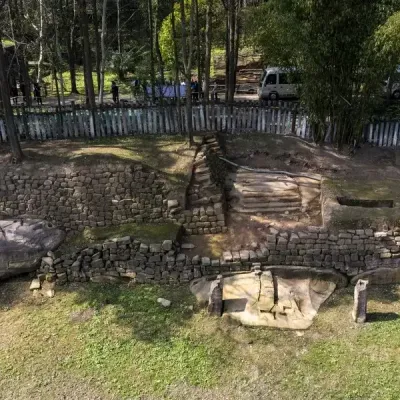 Diaoyu - Ruins of a building complex have been found at the site of Diaoyu City, an ancient fortress in southwest China's Chongqing Municipality, during recent excavation work. This was reported by The Xinhua News Agency. The site was named after the hill on which it was built in the latter period of the Southern Song Dynasty (1127-1279). During the war between the Song imperial army and Mongolian troops in the 13th Century, Diaoyu City, as an essential part of the defense system of the present-day Sichuan Province and Chongqing, withstood outside aggression for 36 years, a miraculous feat. The Diaoyu site is located in the Hechuan District of Chongqing, covering an area of 2.5 square km. The recent archaeological work completed the excavation area of 914 square meters, and newly cleared the city gate, city wall, stone wall, courtyard gate, high platform, a well, pool, road, house site, drainage ditch, and ash pit, among another 33 ruins. It unearthed more than 300 pieces of other cultural relics. Yuan Dongshan, deputy head of Chongqing's institute of cultural relics and archaeology, said the unearthed gates, passageways, piers, and stone walls show that there had been a huge courtyard. The stone size and masonry technology found at the ruins have never been seen before. According to Yuan, the new findings effectively fill in the blanks of the cultural relics of the Song Dynasty in this area and provide new evidence for the study of the defense system, layout, and structural function of the mountainous city of the Song and Yuan Dynasties (960-1368), and play an important role in further reconstructing the spatial pattern of Diaoyu City in the late Southern Song Dynasty.
Diaoyu - Ruins of a building complex have been found at the site of Diaoyu City, an ancient fortress in southwest China's Chongqing Municipality, during recent excavation work. This was reported by The Xinhua News Agency. The site was named after the hill on which it was built in the latter period of the Southern Song Dynasty (1127-1279). During the war between the Song imperial army and Mongolian troops in the 13th Century, Diaoyu City, as an essential part of the defense system of the present-day Sichuan Province and Chongqing, withstood outside aggression for 36 years, a miraculous feat. The Diaoyu site is located in the Hechuan District of Chongqing, covering an area of 2.5 square km. The recent archaeological work completed the excavation area of 914 square meters, and newly cleared the city gate, city wall, stone wall, courtyard gate, high platform, a well, pool, road, house site, drainage ditch, and ash pit, among another 33 ruins. It unearthed more than 300 pieces of other cultural relics. Yuan Dongshan, deputy head of Chongqing's institute of cultural relics and archaeology, said the unearthed gates, passageways, piers, and stone walls show that there had been a huge courtyard. The stone size and masonry technology found at the ruins have never been seen before. According to Yuan, the new findings effectively fill in the blanks of the cultural relics of the Song Dynasty in this area and provide new evidence for the study of the defense system, layout, and structural function of the mountainous city of the Song and Yuan Dynasties (960-1368), and play an important role in further reconstructing the spatial pattern of Diaoyu City in the late Southern Song Dynasty.
https://ukranews.com/en/news/923869-ruins-of-large-scale-building-complex-found-in-china-s-chongqing
TURQUIE – 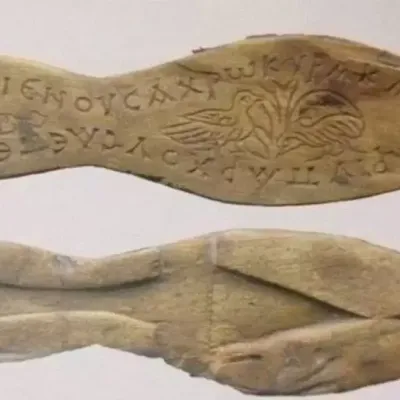
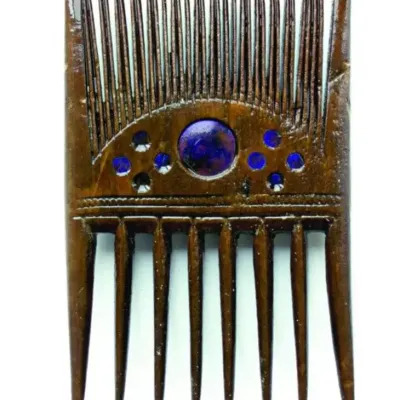 Portus Theodosiacus - The 1,600-year-old sandals and comb unearthed during the excavations of Theodosius Harbor (Portus Theodosiacus), the second-biggest harbor built on the coast of the Marmara Sea, fascinate those who see it. The astonishing finds were discovered during digs prompted by the Marmaray project. One of these interesting finds was sandals with wooden soles belonging to a woman. The sandals had a Greek message that reads: “Use in health, lady, wear in beauty and happiness.” Researchers came to differing conclusions about the sunken ships discovered in the harbor of Theodosius, which dated from different centuries. It was suggested that the ships might have sunk during a hurricane, tsunami, or other natural disasters. The idea that the ships were simply abandoned after serving their purpose is one of the most widely held theories. In the fourth of nine stratigraphic segments in the excavation field, researchers discovered evidence of the effects of the earthquake and tsunami that occurred in AD 553. Another theory is that the southwesterly wind, known as kaçak (fugitive) in Turkish, which begins suddenly in the Marmara Sea during the summer months, caused these vessels to sink. Above the vessels, a thick layer of sea sand formed. The accumulation that filled the harbor protected and preserved the sunken ships. The rapid burial of the ships created an anoxic environment that preserved rigging tools like tackles, pulleys, ropes, and toggles as well as everyday items like combs, leather sandals, straw baskets, and wooden plates as well as a variety of organic and inorganic artifacts like stone and iron anchors. Around the harbor, a number of fragments of sunken ships and items from earlier eras were also discovered.
Portus Theodosiacus - The 1,600-year-old sandals and comb unearthed during the excavations of Theodosius Harbor (Portus Theodosiacus), the second-biggest harbor built on the coast of the Marmara Sea, fascinate those who see it. The astonishing finds were discovered during digs prompted by the Marmaray project. One of these interesting finds was sandals with wooden soles belonging to a woman. The sandals had a Greek message that reads: “Use in health, lady, wear in beauty and happiness.” Researchers came to differing conclusions about the sunken ships discovered in the harbor of Theodosius, which dated from different centuries. It was suggested that the ships might have sunk during a hurricane, tsunami, or other natural disasters. The idea that the ships were simply abandoned after serving their purpose is one of the most widely held theories. In the fourth of nine stratigraphic segments in the excavation field, researchers discovered evidence of the effects of the earthquake and tsunami that occurred in AD 553. Another theory is that the southwesterly wind, known as kaçak (fugitive) in Turkish, which begins suddenly in the Marmara Sea during the summer months, caused these vessels to sink. Above the vessels, a thick layer of sea sand formed. The accumulation that filled the harbor protected and preserved the sunken ships. The rapid burial of the ships created an anoxic environment that preserved rigging tools like tackles, pulleys, ropes, and toggles as well as everyday items like combs, leather sandals, straw baskets, and wooden plates as well as a variety of organic and inorganic artifacts like stone and iron anchors. Around the harbor, a number of fragments of sunken ships and items from earlier eras were also discovered.
https://arkeonews.net/the-secret-of-the-shipwrecks-at-theodosius-harbor-1600-years-old-womens-sandals-and-comb/
ITALIE – 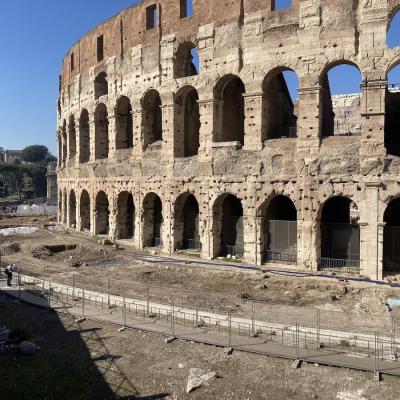 Rome - Since October, archaeologists have been excavating a stretch of some 200 meters of the southern perimeter of the monument. This is the least well-preserved side of the Colosseum, where the entire outer ring of its arches is missing. Built between AD 70 and 80, the Colosseum served as an arena for spectacles for over four centuries. Gladiatorial matches continued until the AD 430s and animal hunts were last mentioned in the 520s. Soon after this, it appears that the building went out of use and serious damage occurred to the southern side, likely due to earthquakes. Collapses continued in subsequent centuries and much of the white, travertine stone was taken away and reused to build the churches and palaces of Medieval and Renaissance Rome. The new excavations have two aims: to understand more fully both the ancient and post-ancient history of the monument; and to better integrate this part of the building with its surrounding piazza, opening a new sector to the public. The latter is very welcome; the former is very challenging. A few weeks ago, passers-by could watch as archaeologists carefully exposed the skeleton of an animal. Shortly after, an update on the ‘dig diary’ confirmed it was a mule, seemingly crushed by falling masonry, which they speculate could have occurred during the famous and devastating earthquake of 1349. Such finds help piece together the long history of the building. Undoubtedly more will be revealed as the digging and analysis continues.
Rome - Since October, archaeologists have been excavating a stretch of some 200 meters of the southern perimeter of the monument. This is the least well-preserved side of the Colosseum, where the entire outer ring of its arches is missing. Built between AD 70 and 80, the Colosseum served as an arena for spectacles for over four centuries. Gladiatorial matches continued until the AD 430s and animal hunts were last mentioned in the 520s. Soon after this, it appears that the building went out of use and serious damage occurred to the southern side, likely due to earthquakes. Collapses continued in subsequent centuries and much of the white, travertine stone was taken away and reused to build the churches and palaces of Medieval and Renaissance Rome. The new excavations have two aims: to understand more fully both the ancient and post-ancient history of the monument; and to better integrate this part of the building with its surrounding piazza, opening a new sector to the public. The latter is very welcome; the former is very challenging. A few weeks ago, passers-by could watch as archaeologists carefully exposed the skeleton of an animal. Shortly after, an update on the ‘dig diary’ confirmed it was a mule, seemingly crushed by falling masonry, which they speculate could have occurred during the famous and devastating earthquake of 1349. Such finds help piece together the long history of the building. Undoubtedly more will be revealed as the digging and analysis continues.
https://www.artandobject.com/news/new-excavations-romes-colosseum
USA – 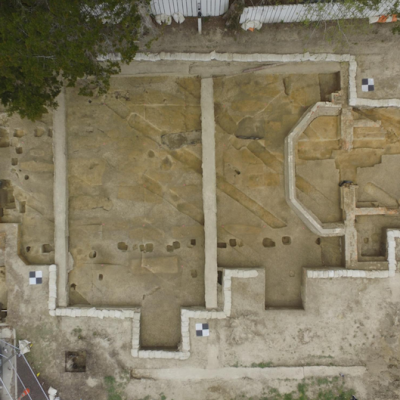 Williamsburg -The Virginia Gazette reports that analysis of DNA samples taken from people who were buried at the site of the historic First Baptist Church on Nassau Street in Colonial Williamsburg has identified descendants among the modern congregation, which has relocated. “That has always seemed like the most logical explanation for these burials, but without definitive proof we couldn’t rule out the possibility that the burials were associated with another group or from a different time period,” said Jack Gary of Colonial Williamsburg. Founded in 1776 by enslaved and free Black people, the original church building was destroyed by a tornado. Another structure was built on top of it in 1856, but the site was eventually paved over. The three sets of remains included in the study have been dated to the early nineteenth century and identified as a man of African descent who was between about 16 and 18 years old at the time of death, and two men who died between the ages of 35 and 45. “Now we can say for sure that these are people connected to the earliest years of First Baptist Church. Now the congregation can decide how to move forward,” Gary concluded.
Williamsburg -The Virginia Gazette reports that analysis of DNA samples taken from people who were buried at the site of the historic First Baptist Church on Nassau Street in Colonial Williamsburg has identified descendants among the modern congregation, which has relocated. “That has always seemed like the most logical explanation for these burials, but without definitive proof we couldn’t rule out the possibility that the burials were associated with another group or from a different time period,” said Jack Gary of Colonial Williamsburg. Founded in 1776 by enslaved and free Black people, the original church building was destroyed by a tornado. Another structure was built on top of it in 1856, but the site was eventually paved over. The three sets of remains included in the study have been dated to the early nineteenth century and identified as a man of African descent who was between about 16 and 18 years old at the time of death, and two men who died between the ages of 35 and 45. “Now we can say for sure that these are people connected to the earliest years of First Baptist Church. Now the congregation can decide how to move forward,” Gary concluded.
https://www.archaeology.org/news/11371-230411-virginia-first-baptist
USA – 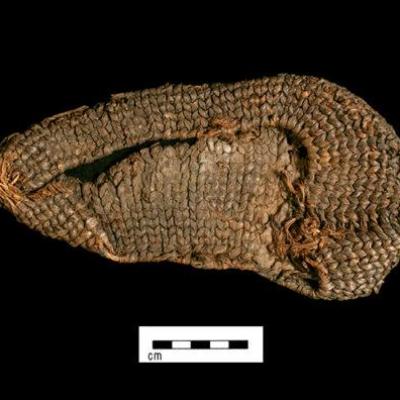
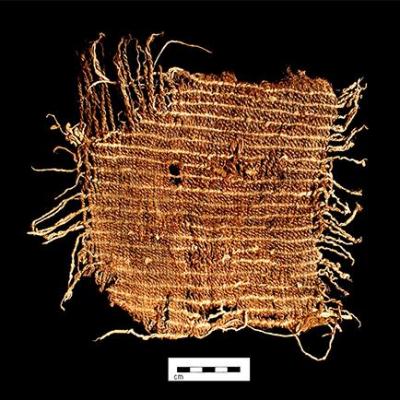 Kentucky - For millennia, Kentucky’s ancient Native peoples wore fancy lace shawls and hard-wearing slippers and sandals, and used heavy-duty bags made from textiles. And just like textiles today, they made their textiles from yarn, used for woven items, or cordage for items like rope. Their fabrics were made from bundles of long, thin strands of twisted plant fibers. They knew which plants produced the best fibers for the textiles they wanted to make: the stems of milkweed, dogbane and stinging nettle for clothing, or the leaves of rattlesnake master for footwear. Native weavers spun the fibers into yarn or cordage by hand using a spindle against their thigh. They did not use spinning wheels. And although they wove many textiles with only a wooden frame, they mostly wove without any frame or support at all. These weavers created complex patterns and designs using colored yarns, dyed or painted with natural pigments like those from sumac and walnuts. Ancient Native craftspeople used two different weaving techniques: twining and plaiting. Twining, which entails twisting two yarns together around a third perpendicular yarn, dates back at least 10,000 years. For plaiting, Native weavers passed yarns over and under each other. They created twill patterns, which are thousands of years old, by changing how many times they passed a horizontal weft yarn over and under a vertical warp yarn. But how do we know about Kentucky’s ancient Native textiles? Textiles – and the yarn and cordage used to make them – are perishable artifacts. They decay over time. Indeed, archaeologists estimate that 90% of the items people made long ago were produced from perishable materials. Fragments of ancient Kentucky yarn, cordage and textiles will preserve when conditions are just right. Archaeologists have found these ancient perishable items in the bone-dry soils of some eastern Kentucky rock shelters and deep within some Kentucky caves, with their constantly cool temperatures.
Kentucky - For millennia, Kentucky’s ancient Native peoples wore fancy lace shawls and hard-wearing slippers and sandals, and used heavy-duty bags made from textiles. And just like textiles today, they made their textiles from yarn, used for woven items, or cordage for items like rope. Their fabrics were made from bundles of long, thin strands of twisted plant fibers. They knew which plants produced the best fibers for the textiles they wanted to make: the stems of milkweed, dogbane and stinging nettle for clothing, or the leaves of rattlesnake master for footwear. Native weavers spun the fibers into yarn or cordage by hand using a spindle against their thigh. They did not use spinning wheels. And although they wove many textiles with only a wooden frame, they mostly wove without any frame or support at all. These weavers created complex patterns and designs using colored yarns, dyed or painted with natural pigments like those from sumac and walnuts. Ancient Native craftspeople used two different weaving techniques: twining and plaiting. Twining, which entails twisting two yarns together around a third perpendicular yarn, dates back at least 10,000 years. For plaiting, Native weavers passed yarns over and under each other. They created twill patterns, which are thousands of years old, by changing how many times they passed a horizontal weft yarn over and under a vertical warp yarn. But how do we know about Kentucky’s ancient Native textiles? Textiles – and the yarn and cordage used to make them – are perishable artifacts. They decay over time. Indeed, archaeologists estimate that 90% of the items people made long ago were produced from perishable materials. Fragments of ancient Kentucky yarn, cordage and textiles will preserve when conditions are just right. Archaeologists have found these ancient perishable items in the bone-dry soils of some eastern Kentucky rock shelters and deep within some Kentucky caves, with their constantly cool temperatures.
https://www.kentuckyteacher.org/bulletin-board/2023/03/uncovering-kentucky-history-ancient-american-indian-textiles/
ITALIE – 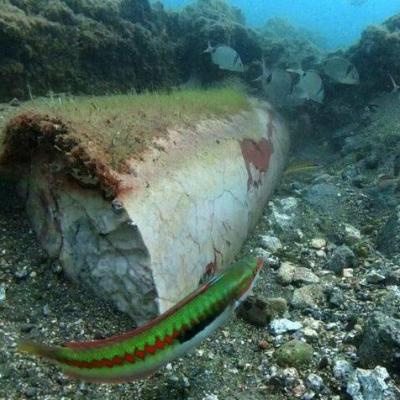
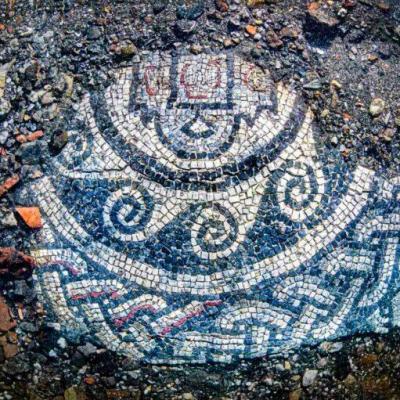 Baia - The submerged spa of Baia has long attracted scuba divers and snorkellers to Italy’s Bay of Naples, but last week staff at the underwater park discovered a previously unsuspected part of the site that had remained unseen since ancient Roman times. The divers noticed pieces of masonry between seagrass beds north of an already excavated area called Terme del Lacus, and on investigation have found “new columns, new floors – a whole new block to play in!” Then on Easter Monday (10 April) in the centre of the Terme del Lacus itself, the park’s divers were excited to find a new mosaic, described as a “psychedelic intertwining of geometric lines made with coloured tiles”. This has yet to be fully revealed. Baia was a fashionable thermal resort for Rome’s elite over a period of six centuries, between 100 BC and 500 AD, with emperors such as Julius Caesar, Nero, Caligula and Hadrian staying in villas there. However, the volcanic activity that created its hot springs also caused the subsidence that gradually sealed its fate. Once described as a “vortex of luxury” and “harbour of vice”, the sunken complex lies just off Pozzuoli. A partially collapsed stone colonnade has already been located, and among a number of columns is one made of precious Portasanta marble imported from the Greek island of Chios. Although broken, it is reported to have been well-preserved. A large section of opus sectile flooring, in which cut materials are inlaid to form a design or picture, has also been identified. This was rendered in marble using alternate white and grey-black and Portasanta pink slabs, which dates the floor to the Baia’s later period of construction. The remains are thought to have formed part of Roman villas.
Baia - The submerged spa of Baia has long attracted scuba divers and snorkellers to Italy’s Bay of Naples, but last week staff at the underwater park discovered a previously unsuspected part of the site that had remained unseen since ancient Roman times. The divers noticed pieces of masonry between seagrass beds north of an already excavated area called Terme del Lacus, and on investigation have found “new columns, new floors – a whole new block to play in!” Then on Easter Monday (10 April) in the centre of the Terme del Lacus itself, the park’s divers were excited to find a new mosaic, described as a “psychedelic intertwining of geometric lines made with coloured tiles”. This has yet to be fully revealed. Baia was a fashionable thermal resort for Rome’s elite over a period of six centuries, between 100 BC and 500 AD, with emperors such as Julius Caesar, Nero, Caligula and Hadrian staying in villas there. However, the volcanic activity that created its hot springs also caused the subsidence that gradually sealed its fate. Once described as a “vortex of luxury” and “harbour of vice”, the sunken complex lies just off Pozzuoli. A partially collapsed stone colonnade has already been located, and among a number of columns is one made of precious Portasanta marble imported from the Greek island of Chios. Although broken, it is reported to have been well-preserved. A large section of opus sectile flooring, in which cut materials are inlaid to form a design or picture, has also been identified. This was rendered in marble using alternate white and grey-black and Portasanta pink slabs, which dates the floor to the Baia’s later period of construction. The remains are thought to have formed part of Roman villas.
https://divernet.com/scuba-news/divers-reveal-new-treasures-in-roman-harbour-of-vice/
KYRGYZSTAN -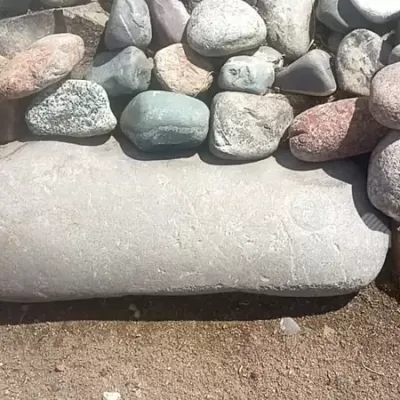 Tarmal-Sai - A deer stone was found in the Tarmal-Sai settlement in the Kochkor district of the Naryn region in eastern Kyrgyzstan. Deer stones, also known as reindeer stones, are ancient megaliths with symbols carved into them. Mongolia is rich with stone sculptures such as deer stones and complex heritage sites that belong to Bronze Age culture. Deer stones name comes from their carved depictions of flying deer. Deer stones are a distinctive feature of the Saka era. A few deer stones have been discovered in Chui valley and Issyk-Kul Lake. Deer stones will usually be found together with extraordinary monuments called khirgisuur, with slab burials or in some cases with petroglyphs forming a complex site. Joldoshbek Butoshev, a resident of Tarmal-Sai, noticed a round stone with drawings while doing irrigation work and brought it home, thinking it might have historical significance. The stone is 1 meter long and weighs approximately 40-50 kilograms. On both sides of the stone, there are ritual sun signs, which are associated with the Saka and Wusun, who worshipped the sun.
Tarmal-Sai - A deer stone was found in the Tarmal-Sai settlement in the Kochkor district of the Naryn region in eastern Kyrgyzstan. Deer stones, also known as reindeer stones, are ancient megaliths with symbols carved into them. Mongolia is rich with stone sculptures such as deer stones and complex heritage sites that belong to Bronze Age culture. Deer stones name comes from their carved depictions of flying deer. Deer stones are a distinctive feature of the Saka era. A few deer stones have been discovered in Chui valley and Issyk-Kul Lake. Deer stones will usually be found together with extraordinary monuments called khirgisuur, with slab burials or in some cases with petroglyphs forming a complex site. Joldoshbek Butoshev, a resident of Tarmal-Sai, noticed a round stone with drawings while doing irrigation work and brought it home, thinking it might have historical significance. The stone is 1 meter long and weighs approximately 40-50 kilograms. On both sides of the stone, there are ritual sun signs, which are associated with the Saka and Wusun, who worshipped the sun.
https://arkeonews.net/deer-stone-discovered-in-kyrgyzstan/